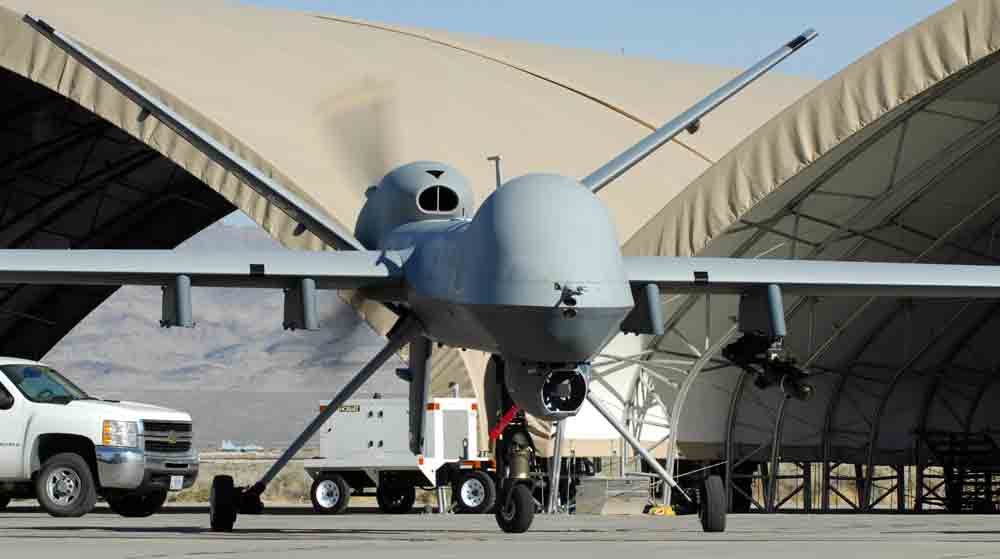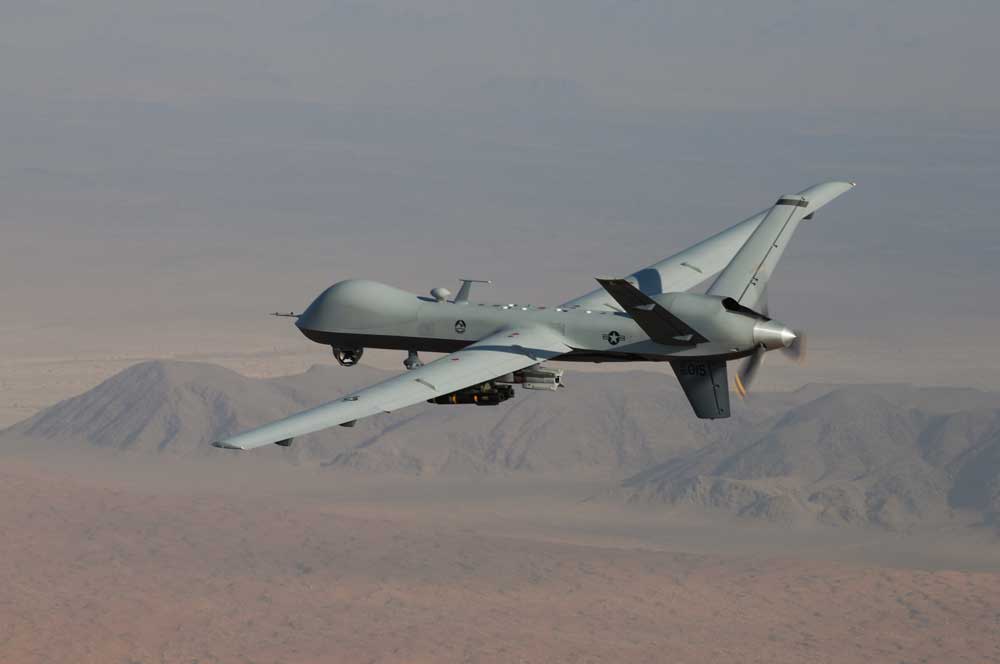The US Sets The Pace for Drone Strikes
The advent of drones like the MQ-9 Reaper have made it easier for militaries to launch attacks like the one the US ordered against Iran's General Soleimani.
Anita Hawser
04 January 2020
 Aircrews perform a preflight check on an MQ-9 Reaper before it takes off on a mission in Afghanistan (Photo:USAF)
Aircrews perform a preflight check on an MQ-9 Reaper before it takes off on a mission in Afghanistan (Photo:USAF)
US DRONE STRIKES
The use of drones to target terrorists or insurgents in the US's so-called War on Terror has resulted in a mininum of more than 6,700 drone strikes being launched, according to the Bureau of Investigative Journalism, which started collecting data on drone stikes in January 2004. But, according to the Bureau, these strikes have not only killed their intended targets, but also resulted in the deaths of hundreds, if not thousands of civilians. Most of the Bureau's data pertains to drone strikes in Afghanistan, Pakistan, Yemen and Somalia.
Since the War on Terror began in the wake of the 9/11 attacks on the World Trade Centre, drone strikes have become the US's favoured weapon of choice for eliminating targets of interest.
There are many reasons why the US favours the use of drones. They can stay in the air for much longer periods than conventional aircraft and can carry various payloads, including high-resolution sensors for detecting and tracking targets and precision weapon systems, which are reportedly designed to reduce collateral damage in built-up areas. Using drones, the US is able to carry out an attack against fast-moving targets much more easily and readily than having to send in boots on the ground.
The MQ-9 Reaper Remotely Piloted Air System (RPAS), which is manufactured by General Atomics Aeronautical Systems, is the drone favoured by the US Air Force (USAF) for precision strikes against targets and was used recently by the US to, in the words of US President Donald Trump, eliminate Iranian General Qasem Soleimani, who Trump claimed was plotting “imminent and sinister attacks on US diplomats and military personnel.”
As the USAF states on its website: “Given its significant loiter time, wide-range sensors, multi-mode communications suite and precision weapons – [the MQ-9] provides a unique capability to perform strike, co-ordination and reconnaissance against high-value, fleeting, and time-sensitive targets.”
The UK's Royal Air Force also operates armed versions of the Reaper drone, as does Italy, but whilst the US is happy to sell drones like the MQ-9 to so-called friendly countries, it has only granted permission to the UK and Italy to arm their drones.
In addition to being fitted with precision weapon systems like the Hellfire missile, “which provides highly accurate, low-collateral damage, anti-armour and anti-personnel engagement capabilities,” the MQ-9 also features an array of sophisticated cameras and sensors for detecting and tracking targets. These sensors include an infrared sensor, color/monochrome daylight TV camera, image-intensified TV camera, laser range finder /designator and laser illuminator.
Arguably, the advent of drones like the MQ-9 Reaper have made it easier for militaries to launch attacks like the one against General Soleimani; some may argue a little too easy, with some world leaders questioning the rationale for the strike on Soleimani, which is expected to unleash a wave of retaliatory attacks and further fracture already delicate US-Iran relations, as well as the US's relationship with Iraq. In the past, such strikes against so-called enemies of the state would have required significantly longer and more detailed military planning and logistics in terms of getting equipment and personnel to the exact location in order to launch such an attack.
OBAMA SET THE PACE FOR US DRONE STRIKES
Interestingly, while the US only really started using drones with the onset of the war in Afghanistan, according to data published by the Bureau of Investigative Journalism, drone strikes by the US were more prevalent under President Barack Obama, who launched 10 times more strikes than his predecessor George Bush. “Obama embraced the US drone programme, overseeing more strikes in his first year than Bush carried out during his entire presidency,” the Bureau states. “A total of 563 strikes, largely by drones, targeted Pakistan, Somalia and Yemen during Obama’s two terms, compared to 57 strikes under Bush,” the Bureau writes.
The US's reliance on armed drones has continued under the Trump administration. In Afghanistan, where Coalition troops officially withdrew in 2014, the Bureau says that the US is the only Air Force “known to be flying fast jets or armed drones”, which are purportedly targeting members of the Taliban.
According to information compiled by Jane's and published by The Guardian, the US is expected to buy more than 1,000 combat drones over the next decade, making it the largest investor in this technology, followed by China. Another interesting development will be the certification of US military drones to fly in civilian airspace. The Reaper is not certified to fly in US domestic airspace, so has to be operated from remote bases and in theatres of operation under military airspace control.
But General Atomics' MQ-9B SkyGuardian platform, a variant of which will form the basis for the UK Royal Air Force's Reaper replacement programme, called the Protector, will be certified to fly in UK civilian airspace, which raises a whole range of ethical, legal and safety issues regarding how these surveillance and weapon platforms are likely to be used in future. Could they, in fact, be used to take out so-called enemies of the state on US or UK soil?
There are, however, some misconceptions regarding drones like the Reaper. In the mainstream press, they are often described as clinical killing machines devoid of the “risk and rigour” associated with traditional military operations. There is a lot of emphasis on the word 'unmanned,' but RPAS typically require a crew of two to three people to operate them, including a pilot, sensor operator and Mission Intelligence Co-ordinator.

DEBUNKING MYTHS ABOUT REAPER OPERATORS AND OPERATIONS
Research conducted by Dr. Peter Lee, a Reader in Politics and Ethics at the University of Portsmouth, the author of Reaper Force: Inside Britain’s Drone Wars (October 2018), debunks some of the myths surrounding the use of drones like the Reaper.
The biggest myth, says Lee, is that Reaper operators are not exposed to risk. RPAS operators are typically located thousands of kilometres away from their targets or the battlefields where they operate. But whilst these pilots may not be subjected to the physical risks normally associated with combat, Lee says drone operators can be exposed to the same levels of combat stress and mental trauma as pilots of manned aircraft.
A Reaper operator at Creech Air Force Base in Nevada, which is the chief operational base for the US's Reaper fleet, who Lee interviewed for his book stated:
“I’ve killed the enemy from both [conventional aircraft] and from the Reaper. The body’s reactions are the same — it surprised me. Your mouth goes dry and the hairs on the back of your neck stand up. Everything goes tense and you get that sick feeling in your stomach. You know what you are about to do.”
Lee links the mental trauma of Reaper operators to the use of high-resolution sensors, which vividly depict what the operator is about to do and the aftermath of a strike. Lee says that Reaper sorties lasting up to 14 hours add rigour to drone operations with the concentration inherent in providing enduring intelligence, surveillance and reconnaissance and strike capabilities. These duties continue for the duration of a two-to-three-year Royal Air Force tour on Reaper and not just for a four-to-six-month deployment, says Lee.
“While the pilot is busy flying the aircraft and the sensor operator is operating the multi-spectral targeting system (MTS ball), the mission co-ordinator is also engaged by providing real-time intelligence,” states a description of a Reaper mission on the USAF's website.
“They’re looking for changes in terrain, weather, threats and weapons systems because intelligence personnel can provide everything real time to the pilot and sensor (MTS ball). Also supporting the crew is the distributed ground system, which the USAF says is “a group of imagery analysts who watch the live feed coming from the aircraft. They are able to determine the difference between a woman holding a child and a man holding a gun on zoomed-in images.”
During USAF Reaper operations, mission tasks are assigned by air operations centres under the respective combatant commands. These centers determine where the aircraft will go, what mission is needed, and also give orders and guidance should the need for change occur.
“The main job of the [operations centre] is to take care of the guys flying the mission to ensure mission success,” said Maj. Steven, the 432nd WG/432nd AEW WOC deputy director. “In the operations centre we’re making sure crews are available, the weather is good, and planes can take off and fly with no problems, basically we’re monitoring all the factors so the mission can go smoothly.”
US REAPER FAST FACTS
Primary function: Find, fix, and finish targets
Contractor: General Atomics Aeronautical Systems, Inc.
Wingspan: 66 feet (20.1 meters)
Length: 36 feet (11 meters)
Height: 12.5 feet (3.8 meters)
Weight: 4,900 pounds (2,223 kilograms) empty
Maximum takeoff weight: 10,500 pounds (4,760 kilograms)
Fuel capacity: 4,000 pounds (602 gallons)
Payload: 3,750 pounds (1,701 kilograms)
Speed: Cruise speed around 230 mph (200 knots)
Range: 1,150 miles (1,000 nautical miles)
Ceiling: Up to 50,000 feet (15,240 meters)
Armament: Combination of AGM-114 Hellfire missiles, GBU-12 Paveway II and GBU-38 Joint Direct Attack Munitions
Crew (remote): Two (pilot and sensor operator)
Unit cost: $64.2 million (includes four aircraft, sensors, GCSs, and Comm.) (fiscal 2006 dollars)
Initial operating capability: October 2007
Inventory: Total force, 93 (this number is likely to have increased significantly)
Information current as of September 2015